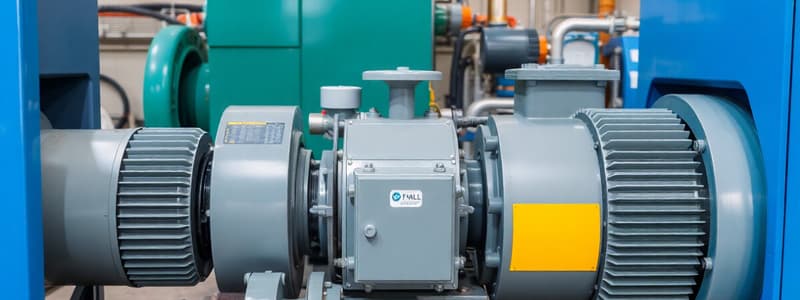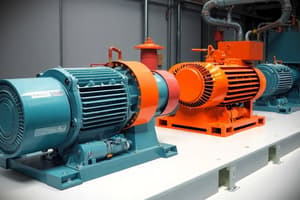Podcast
Questions and Answers
What is the primary function of a generator in the context of electric machines?
What is the primary function of a generator in the context of electric machines?
- To generate mechanical power from heat energy.
- To store energy for later use.
- To convert electrical power into mechanical power.
- To convert mechanical power into electrical power. (correct)
What efficiency range is typically associated with steam turbines as prime movers?
What efficiency range is typically associated with steam turbines as prime movers?
- 80–90%
- 40–50% (correct)
- 30–40%
- 50–60%
Why are transformers essential to the electric power system?
Why are transformers essential to the electric power system?
- They change voltage levels while maintaining the same frequency. (correct)
- They store electrical energy for future use.
- They only generate electricity.
- They convert electrical energy into mechanical energy.
What is the maximum voltage at which electric power is typically generated before being transformed?
What is the maximum voltage at which electric power is typically generated before being transformed?
How are high voltages and low currents beneficial for power transmission?
How are high voltages and low currents beneficial for power transmission?
In an electric power system, what happens to the voltage close to the usage point?
In an electric power system, what happens to the voltage close to the usage point?
What is the primary source of mechanical power used in generating electricity?
What is the primary source of mechanical power used in generating electricity?
What is an electric machine's primary energy conversion process?
What is an electric machine's primary energy conversion process?
What type of transformer is used to increase voltage levels?
What type of transformer is used to increase voltage levels?
Which type of transformer is primarily designed to reduce voltage levels?
Which type of transformer is primarily designed to reduce voltage levels?
What is a characteristic advantage of using iron-core transformers compared to air-core transformers?
What is a characteristic advantage of using iron-core transformers compared to air-core transformers?
Which construction method is most commonly employed for power transformers?
Which construction method is most commonly employed for power transformers?
In which application are transformers crucial in communication systems?
In which application are transformers crucial in communication systems?
Why are transformers essential in industrial applications?
Why are transformers essential in industrial applications?
What type of transformer is used for electrical isolation between circuits?
What type of transformer is used for electrical isolation between circuits?
What is a key function of transformers in power transmission systems?
What is a key function of transformers in power transmission systems?
What type of transformer is used when the secondary voltage is lower than the primary voltage?
What type of transformer is used when the secondary voltage is lower than the primary voltage?
Which type of transformer typically operates at higher power levels and voltages?
Which type of transformer typically operates at higher power levels and voltages?
What is the primary purpose of an iron-core in a transformer?
What is the primary purpose of an iron-core in a transformer?
What is a significant characteristic of one-to-one transformers?
What is a significant characteristic of one-to-one transformers?
Which materials are typically used in the construction of iron-core transformers?
Which materials are typically used in the construction of iron-core transformers?
In what scenario might a transformer be utilized as both a step-up and step-down transformer?
In what scenario might a transformer be utilized as both a step-up and step-down transformer?
What is a key function of electronic transformers?
What is a key function of electronic transformers?
What is the primary factor that affects the induced voltage in the secondary winding of a transformer?
What is the primary factor that affects the induced voltage in the secondary winding of a transformer?
What characteristic differentiates an air-core transformer from other transformers?
What characteristic differentiates an air-core transformer from other transformers?
Which of the following constructions is specifically designed to reduce leakage in transformers?
Which of the following constructions is specifically designed to reduce leakage in transformers?
Why are core-type transformers preferred for high-voltage installations?
Why are core-type transformers preferred for high-voltage installations?
In which construction type are the low-voltage and high-voltage windings wound concentrically?
In which construction type are the low-voltage and high-voltage windings wound concentrically?
What advantage does a shell-type transformer have over a core-type transformer?
What advantage does a shell-type transformer have over a core-type transformer?
What is the main application of air-core transformers?
What is the main application of air-core transformers?
What factor significantly influences transformer behavior due to flux leakage?
What factor significantly influences transformer behavior due to flux leakage?
Which transformer type allows for visual inspection of coils for maintenance?
Which transformer type allows for visual inspection of coils for maintenance?
Flashcards
Electric Machines
Electric Machines
Devices used in various industrial and manufacturing processes to convert between electrical and mechanical power.
Generator
Generator
A rotating device that converts mechanical power into electrical power.
Prime Mover
Prime Mover
The basic source of mechanical power, typically a steam or hydraulic turbine.
Transformer
Transformer
Signup and view all the flashcards
AC Power
AC Power
Signup and view all the flashcards
Transmission Losses
Transmission Losses
Signup and view all the flashcards
Transformer
Transformer
Signup and view all the flashcards
Working Principle of a Transformer
Working Principle of a Transformer
Signup and view all the flashcards
Step-up Transformer
Step-up Transformer
Signup and view all the flashcards
Step-down Transformer
Step-down Transformer
Signup and view all the flashcards
One-to-one Transformer
One-to-one Transformer
Signup and view all the flashcards
Electronic Transformer
Electronic Transformer
Signup and view all the flashcards
Power Transformer
Power Transformer
Signup and view all the flashcards
Iron-core Transformer
Iron-core Transformer
Signup and view all the flashcards
Transformer
Transformer
Signup and view all the flashcards
Transformer uses
Transformer uses
Signup and view all the flashcards
Transformer in AC Power
Transformer in AC Power
Signup and view all the flashcards
Transformer in Electronics
Transformer in Electronics
Signup and view all the flashcards
Transformer Analysis
Transformer Analysis
Signup and view all the flashcards
Static Device
Static Device
Signup and view all the flashcards
Magnetic Medium
Magnetic Medium
Signup and view all the flashcards
Air-core transformer
Air-core transformer
Signup and view all the flashcards
Core-type transformer
Core-type transformer
Signup and view all the flashcards
Shell-type transformer
Shell-type transformer
Signup and view all the flashcards
Leakage flux
Leakage flux
Signup and view all the flashcards
Reducing leakage
Reducing leakage
Signup and view all the flashcards
LV winding
LV winding
Signup and view all the flashcards
HV winding
HV winding
Signup and view all the flashcards
Concentric coils
Concentric coils
Signup and view all the flashcards
Pancake coils
Pancake coils
Signup and view all the flashcards
Core-type vs. shell-type transformer choice
Core-type vs. shell-type transformer choice
Signup and view all the flashcards
Transformer lamination
Transformer lamination
Signup and view all the flashcards
Study Notes
Introduction
- Electric machines are crucial in almost every industrial and manufacturing process.
- Applications range from large generators (500 MW and above) to industrial motors and fractional-kW domestic appliances, even sophisticated aerospace applications.
Electric Machines
- Electricity isn't naturally stored in large amounts and must be continually generated.
- Converting mechanical energy to electrical energy is the most efficient way to do so.
- Electric power generation often involves losses within the generator (efficiencies in large generators are above 90%).
- Mechanical power generation is typically derived via heat power (steam turbine, efficiency 40-50%), or potential energy conversion (hydraulic turbines with minimal loss).
- The primary source of mechanical power (steam/hydraulic turbines) is called the prime mover.
Electro-mechanical Energy Conversion Devices
- Electro-mechanical devices convert energy between electrical and mechanical forms.
- Motors change electrical energy to mechanical energy.
- Generators convert mechanical energy into electrical energy.
- This conversion is reversible in the same device.
- Examples of motor uses include industrial machinery and domestic appliances like refrigerators, fans, and pumps.
- Various natural sources are used in generators for power plants (hydro-electric, steam, diesel, and nuclear powered).
Transformer
- A transformer is a static device used to transfer AC power between two circuits.
- It changes voltage levels while maintaining the frequency.
- Transformers are crucial for increasing generation voltage to high transmission voltages for efficient transport.
- Then, the voltage is decreased near the consumer for safety.
- Typical utility voltages range are 380/220 V
Section 1-1 Checkup
- An electro-mechanical device converts electrical energy to mechanical energy or vice versa.
Prime Mover
- A prime mover is a source-engine that converts energy into mechanical energy and transmits power/motion to another device.
Basic Principle of Electric Machines
- There are three basic types of rotating electric machines: DC, polyphase synchronous (AC), and polyphase induction (AC).
- Key materials used in machine manufacture include steel (magnetic flux conductors), copper/aluminum (electrical current conductors), and insulation (isolating voltages).
Studying That Suits You
Use AI to generate personalized quizzes and flashcards to suit your learning preferences.




